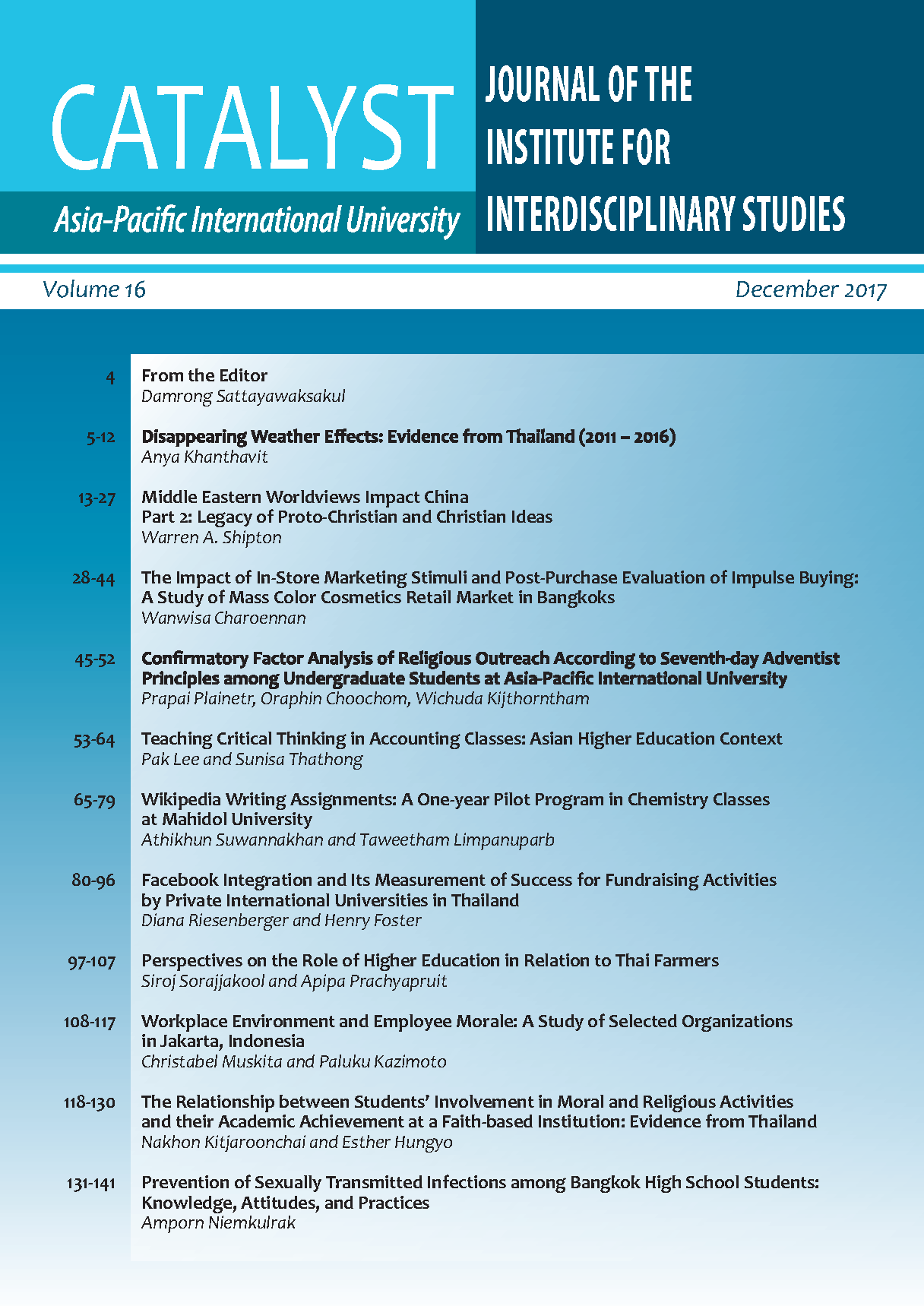Prevention of Sexually Transmitted Infections among Bangkok High School Students: Knowledge, Attitudes, and Practices
Main Article Content
Abstract
This survey research studied the correlation between knowledge, attitudes, and practices to prevent sexually transmitted infections (STIs) among students in High School Educational Regions 1 and 2, Bangkok, Thailand. It also compared their STI prevention practices according to their gender and parents’ marital status. A total of 349 high school students who were selected using a multi-stage quota sampling procedure responded to the survey. The correlation between students’ knowledge, attitudes, and practices was examined using Pearson’s Product-Moment Correlation. Their knowledge was negatively correlated with their attitudes, but their attitudes were positively correlated with their STI prevention practices. STI prevention practices were then compared between genders and among three groups based on parents’ marital status using oneway ANOVA, Independent t-test, and Scheffe’s Post Hoc test. Female students generally had higher levels of STI prevention practices than did male students at a statistically significant level of 0.05. However, parental marital status did not have a statistically significant effect on STI prevention practices. The results of the study emphasize the importance of adolescent sex education and the promotion of appropriate sexual attitudes and practices.
Article Details

This work is licensed under a Creative Commons Attribution-NonCommercial-NoDerivatives 4.0 International License.
Copyright: Asia-Pacific International University reserve exclusive rights to publish, reproduce and distribute the manuscript and all contents therein.
References
Annual Epidemiological Surveillance Report 2012. Sexually Transmitted Infections. Retrieved from http://www.boe. moph.go.th/Annual/AESR2012/main/AESR55_Part1/ file6/3155_STI.pdf.
Annual Epidemiological Surveillance Report 2014. Sexually Transmitted Infections. Retrieved from http://www.boe. moph.go.th/Annual/AESR2012/main/AESR55_Part1/ file6/3155_STI.pdf.
Annual Epidemiological Surveillance Report 2015. Sexually Transmitted Infections. Retrieved from http://www.boe. moph.go.th/Annual/AESR2012/main/AESR55_Part1/ file6/3155_STI.pdf.
Boontham, A. (1992). Comparing factors that predict risky sexual behavior and HIV infections among rural and urban high school students in Nakhon Ratchasima Province. Mahidol University: Bangkok. Retrieved from https://doi.org/10.14457/mu.the.1992.12.
Bureau of Standards, Social Development and Human Security (2010). The role of families in preventing premature pregnancies among Thai adolescents. Office of the Permanent Secretary, Ministry of Social Development and Human Security. Retrieved from https://www.msociety.go.th/ewtadmin/ewt/mso_web/article_ attach/12781/17029.pdf.
Chualee, S., and Narongsang, N. (2007). Knowledge, attitudes, and design for teaching sex education in the family: a case study of Ubon Ratchathani Province. Bureau of Disease Prevention and Control 7, Department of Disease Control, Ministry of Public Health. Retrieved from https://irem2.ddc.moph.go.th/researches/ download/files/4185.
Huebner A., and Howell L. (2003). Examining the relationship between adolescent sexual risk-taking and perceptions of monitoring, communication, and parenting styles. Journal of Adolescence Health 33(2), 71-78.
Jongvannasiri, M. (2006). The effectiveness of friends’ activities helping each other oppose risky sexual behaviors of grade 9 students at Nawamintrachutit Satriwithaya School, Putamonton, Bangkok Metropolitan Area. Thesis for the Degree of Master of Science, Major in Health Education, Srinakarintaraviroj University.
Karnjanavasri, T. (2014). Sexual knowledge awareness. Bangkok: Chulalongkorn University Printing Office.
Kongkekkuat, N., Kitiyaovamarn, R., Daengsaard, E. (2015). (Eds). Guidelines for the treatment of Sexually Transmitted Diseases. Department of Disease Control, Ministry of Public Health.
Lederman, R., Chan, W., & Roberts-Gray, C. (2008). Parent-adolescent relationship education (PARE): program delivery to reduce risk for adolescent pregnancy and STDs. Behavioral Medicine 33(4), 137-143.
Moombanchao, P. (1994). Behavior problems in junior high school adolescents under the Department of General Education, Lopburi Province. Thesis for the Degree of Master of Psychiatry, Chulalongkorn University. Retrieved from http://cuir.car.chula.ac.th/handle/123456789/34307.
Nienkun, S., and Sornchai, S. (2013). Factors related with sexual communication between parents and children entering adulthood. Journal of Phapaklo, Nursing College 24 (2), 36-46.
Office of Standards, Thai Ministry of Social Development and Human Security (2010). Role of families in preventing untimely pregnancies among Thai teenagers. Retrieved from https://www.msociety.go.th/ewtadmin/ewt/ mso_web/article_attach/12781/17029.pdf.
Petkal, A. (2008). Factor relating to sexual behaviors among adolescents in the upper south of Thailand. Thesis for the Degree of Master of Science in Public Health, Major in Health Education and Behavioral Sciences, Mahidol University. Retrieved from http://mulinet11.li.mahidol.ac.th/thesis/2551/cd420/4637236.pdf.
Phomrain, S. (2007). Sexual risky behaviors of secondary school students in Srinakarintaravirkoj Demonstration School, Patoomwan, Bangkok. Thesis for the Degree of Master of Science Program in Health Education, Srinakarintaraviroj University.
Phosri, S. (2004). Personal and family factors affecting sexual risk behaviors of Srinakarintaraviroj university students. Thesis for the Degree of Master of Home Economics, Sukothaithammathiraj University, Bangkok.
Poopaiboon, R. (2004). Participatory adolescent health promotion. Department of Nursing, Faculty of Medicine, Ramathibodi Hospital, Bangkok.
Ravajai, N. (2011). Factors influencing sexual risk preventive behaviors of students in Vocational Education Commission, Bangkok Metropolis. Thesis for the Degree of Master of Science, Major in Health Education, Srinakarintaraviroj University.
Sethaboot, J., and Sirirasmee, B. (2002). Gender roles and reproductive health practices among teenagers in Uttaradit Municipality. Research report, Institute for Population and Social Research, Mahidol University.
Sookrat, B. (2014). Teenage Pregnancy: Policies, Implementation Guidelines, Follow Up, and Evaluation (2nd edition). Bureau of Reproductive Health, Department of Health, Ministry of Public Health. Nonthaburi: The Agricultural Cooperatives’ Association of Thailand Publishing House.
Srichai, J., Hiranthanavivat N., and Viketkarn A. (2005). Knowledge, attitude, and practice about safe sex among adolescent students in Phrae Municipality, Phrae Province. Thesis for the Degree of Master of Community Medicine, Faculty of Medicine, Naresuan University.
Srisa-ad, B. (2013). Introduction to research. (9th edition). Syvuriyasarn Company.
Uavitayasuporn, K., and Phomuentip, O. (2011). Knowledge and attitudes regarding sexually risky behavior by teenagers, Muang District, Nakhon Ratchasima Province. Journal of Boromarajonani College of Nursing, 17(2), 15-26.
World Health Organization. (2016). Sexually transmitted infections (STIs). Retrieved from http://www.who.int/ mediacentre/factsheets/fs110/en/
Yingpaiboonsook, U., and Karuehadej, P. (2011). Students’ sexuality in Rattanakosin District: a case study at Suan Sunandha Rajabhat University. Research report retrieved from http://www.ssruir.ssru.ac.th/bitstream/ ssruir/ 592/1/208-54.pdf


